Offense
Quarterback—Roger Staubach of Navy (1962−1964)
Running backs—Jim Brown of Syracuse (1954−1956) and Herschel Walker of Georgia, (1980−1982)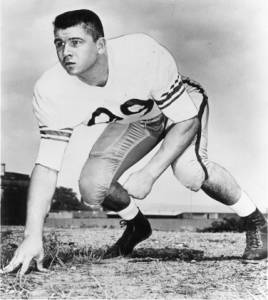
Receivers—Jerry Rice of Mississippi Valley State (1981−1984) and Larry Fitzgerald of Pittsburgh (2002−2003)
Tight end—Mike Ditka of Pittsburgh (1958−1960)
Offensive linemen—Chuck Bednarik of Pennsylvania (1945−1948), Jim Parker of Ohio State (1954−1956), John Hannah of Alabama (1970−1972), Bill Fralic of Pittsburgh (1981−1984) and Orlando Pace of Ohio State (1994−1996)
All-purpose player—Johnny Rodgers of Nebraska (1970−1972)
Punter—Ray Guy of Southern Mississippi (1970−1972)
Kicker—Sebastian Janikowski of Florida State (1997−1999)
Defense
Defensive linemen—Bronko Nagurski of Minnesota (1927−1929), Lee Roy Selmon of Oklahoma (1972−1975), Hugh Green of Pittsburgh (1977−1980) and Reggie White of Tennessee (1980−1983)
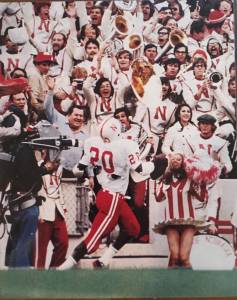 Linebackers—Dick Butkus of Illinois (1962−1964), Tommy Nobis of Texas (1963−1965) and Lawrence Taylor of North Carolina (1977−1980)
Linebackers—Dick Butkus of Illinois (1962−1964), Tommy Nobis of Texas (1963−1965) and Lawrence Taylor of North Carolina (1977−1980)
Defensive backs—Jack Tatum of Ohio State (1968−1970), Ronnie Lott of Southern California (1977−1980), Deion Sanders of Florida State (1985−1988) and Charles Woodson of Michigan (1995−1997)
There they are, the greatest college football players of all time, position by position. The fellas at ESPN knew they were taking on a hopeless task and that some people (me, for example) would come in like bushwhackers and give them the business. Actually, I applaud them for trying. I do not mean to say they are fools who know nothing of the gridiron game, its history and its culture. Obviously, they are fairly versant on this and other sports topics—as they should be. I think several of their choices are on the mark and beyond doubt. In some cases, however, I tentatively offer alternatives. And in others, I say uh-uh, nuh-uh, no way.
Remember, this is strictly about the college game. What a guy did or didn’t do in the pros should not enter into the equation. The ESPNers are sometimes guilty of what we in the intellectual property field call “hindsight bias”; if Joe Smith or Bill Jones rose to prominence in the NFL, he must have shone just as brightly in college. Well, not necessarily, as I will demonstrate.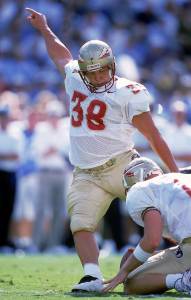
Notice anything odd about the institutions of higher learning at which the above 25 gentlemen matriculated? Four of them attended the University of Pittsburgh (and neither running back Tony Dorsett nor quarterback Dan Marino was named).
Statistics, as we all know, can be deceiving. An excellent player can have so-so stats, depending on a variety of circumstances. By the same token, a merely good player may appear to be all-world if we just go by his numbers which can be influenced by rule changes, overzealous SIDs and the gradual evolution of the game from 1869 to the present.
It helps if he was a winner, but I see no reason to penalize a player who happened to be on a lowly team. Other rather obvious questions are, Did he have a good college career from start to finish? Did he come up big in big games? Was he versatile? (I will now waffle and say that versatility is important only up to a point. Defensive backs Sanders and Woodson also returned punts and kickoffs [the latter 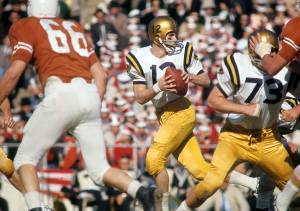 caught 21 passes and did nine end-arounds for the Wolverines], but that is irrelevant. Nagurski, Bednarik, Parker, Ditka, Butkus and Nobis went both ways, offense and defense, but that is also irrelevant. Guy was a three-year starter at safety for USM. Big deal. That tells us nothing about whether he was the best punter in the history of the game. Quite a few of these men played multiple sports in college—Brown played lacrosse for the Orangemen, Staubach was captain of the Navy baseball team, and Hannah threw the shot and discus at Bama, for example—but that is, you know, irrelevant.)
caught 21 passes and did nine end-arounds for the Wolverines], but that is irrelevant. Nagurski, Bednarik, Parker, Ditka, Butkus and Nobis went both ways, offense and defense, but that is also irrelevant. Guy was a three-year starter at safety for USM. Big deal. That tells us nothing about whether he was the best punter in the history of the game. Quite a few of these men played multiple sports in college—Brown played lacrosse for the Orangemen, Staubach was captain of the Navy baseball team, and Hannah threw the shot and discus at Bama, for example—but that is, you know, irrelevant.)
Being named all-America—the main criterion for inclusion in the College Football Hall of Fame—is also a dubious measure. I can easily name a couple of dozen truly great players who never made A-A and just as many forgettable ones who did. The same can be said about winning the Heisman Trophy or other such awards.
Enough of these preliminaries. Let’s get started!
As much as I admire Staubach as a player, competitor and leader, he does not belong on this list. He threw 18 touchdowns and 20 interceptions for the Middies, and in his senior season he rushed for minus one yard. Not good enough. There are six men I consider more worthy: Johnny Bright of Drake 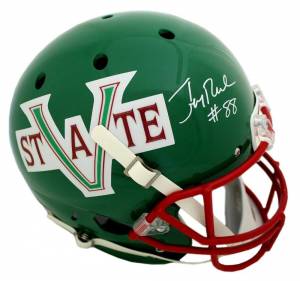 (1949−1951), John Elway of Stanford (1979−1982), Tommie Frazier of Nebraska (1992−1995), Peyton Manning of Tennessee (1994−1997), Vince Young of Texas (2003−2005) and Trevor Lawrence, the current QB at Clemson.
(1949−1951), John Elway of Stanford (1979−1982), Tommie Frazier of Nebraska (1992−1995), Peyton Manning of Tennessee (1994−1997), Vince Young of Texas (2003−2005) and Trevor Lawrence, the current QB at Clemson.
Brown’s inclusion is debatable. He played for an eastern school, Syracuse, at a time when eastern football was weak. But he led the nation in rushing and averaged 6.2 yards per carry his senior year. I know I am contradicting myself by discussing the Heisman Trophy, but Brown should have won it in 1956—not Paul Hornung, quarterback of a 2-8 Notre Dame team. Racism, I contend, is the main reason he finished fifth; there was no black Heisman winner until Ernie Davis, also of Syracuse, in 1961, and that is just ridiculous. I’m also OK with Walker, although he was not very shifty. Perhaps just as deserving are Eric Dickerson of SMU (1979−1982), Bo Jackson of Auburn (1982−1985), Ricky Williams of Texas (1995−1998) and Adrian Peterson of Oklahoma (2004−2006). I exclude O.J. Simpson of USC (1967−1968) because he played just two seasons.
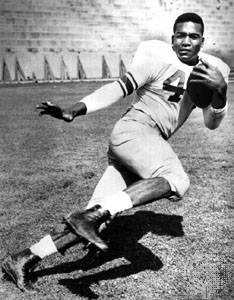 I initially thought Rice personified hindsight bias, but he was indeed quite a player all four years for the Delta Devils. I do not include Fitzgerald because he played just two years at Pitt. That goes for Randy Moss of Marshall (1996−1997) too. I submit that Howard Twilley of Tulsa (1963−1965), Jerry LeVias of SMU (1966−1968), Peter Warrick of Florida State (1996−1999), Ryan Broyles of Oklahoma (2008−2011) and Zay Jones of East Carolina (2013−2016) could take the place vacated by Fitzgerald.
I initially thought Rice personified hindsight bias, but he was indeed quite a player all four years for the Delta Devils. I do not include Fitzgerald because he played just two years at Pitt. That goes for Randy Moss of Marshall (1996−1997) too. I submit that Howard Twilley of Tulsa (1963−1965), Jerry LeVias of SMU (1966−1968), Peter Warrick of Florida State (1996−1999), Ryan Broyles of Oklahoma (2008−2011) and Zay Jones of East Carolina (2013−2016) could take the place vacated by Fitzgerald.
There’s more to playing tight end than catching passes, but Ditka had a puny 45 receptions and seven TD’s at Pitt. By no stretch of the imagination is he the best tight end in college football history. What about Ron Kramer of Michigan (1954−1956), Ted Kwalick of Penn State (1966−1968), Aaron Hernandez of Florida (2007−2009) or Chase Coffman of Missouri (2005−2008)?
Although I have no quibble with any of the five offensive linemen, ESPN listed two Buckeyes (Parker and Pace), and one has to go. I choose Parker. In his place I would put Anthony Munoz of Southern California (1977−1979), Tony Mandarich of Michigan State (1985−1988)—yes, I know he was soon to become the 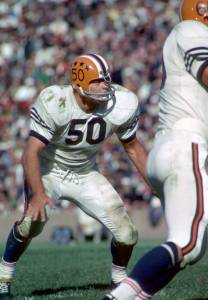 poster boy for steroid abuse—or Jonathan Ogden of UCLA (1992−1995).
poster boy for steroid abuse—or Jonathan Ogden of UCLA (1992−1995).
They have Rodgers as the all-purpose player, and I surely remember him with the Cornhuskers. But was he better than Eric Metcalf of Texas (1985−1988)? The numbers say no. Rodgers’ legacy is tied too closely to that splendid punt-return TD against Oklahoma in 1971.
Guy is generally thought of as the ne plus ultra of punters. But please, let’s remember Sammy Baugh of TCU (1934−1936), Russell Erxleben of Texas (1975−1978) and Reggie Roby of Iowa (1979−1982). All of them could send the ball into the stratosphere.
I concur with the choice of Janikowski as the kicker, but it’s not like there have been no other great ones. Jan Stenerud of Montana State (1964−1966), the aforementioned Erxleben of UT, Steve Little of Arkansas (1974−1977), Matt Bahr of Penn State (1975−1978), Tony Franklin of Texas A&M (1975−1978), Kevin Butler of Georgia (1981−1984) and Kris Brown of Nebraska (1995−1998) were more than competent.
As for the defensive line, Green was a stud, but I see too many Pitt Panthers on this list and he has to go. I would replace him with Bubba Smith of Michigan State (1964−1966). Nagurski? I hate to say that no 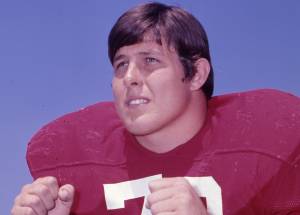 guys from the olden days could compete. Using an example from a different sport, I believe Honus Wagner in his prime would be a star shortstop even today. As a possible replacement for Nagurski, I give you Joe Greene of North Texas (1966−1968), Ted Hendricks of Miami (1966−1968), Tracy Rocker of Auburn (1985−1988), Steve Emtman of Washington (1989−1991), Julius Peppers of North Carolina (1998−2001) and Jadeveon Clowney of South Carolina (2011−2013). My preferred option is a man who predates Nagurski: Paul Robeson of Rutgers (1915−1918). Robeson was truly ahead of his time and has, I believe, been shortchanged by football historians.
guys from the olden days could compete. Using an example from a different sport, I believe Honus Wagner in his prime would be a star shortstop even today. As a possible replacement for Nagurski, I give you Joe Greene of North Texas (1966−1968), Ted Hendricks of Miami (1966−1968), Tracy Rocker of Auburn (1985−1988), Steve Emtman of Washington (1989−1991), Julius Peppers of North Carolina (1998−2001) and Jadeveon Clowney of South Carolina (2011−2013). My preferred option is a man who predates Nagurski: Paul Robeson of Rutgers (1915−1918). Robeson was truly ahead of his time and has, I believe, been shortchanged by football historians.
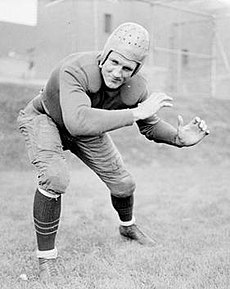 Butkus, Nobis and Taylor were all demonstrably great linebackers with the Illini, Longhorns and Tar Heels, respectively. But Taylor appears to be another example of hindsight bias since he turned into such a superstar with the New York Giants. He was not made a linebacker at UNC until his junior season, and two years is an insufficient sample. He’s out, too. So who is our third LB? Maybe George Webster of Michigan State (1964−1966), maybe Mike Singletary of Baylor (1977−1980), maybe the Norman Nightmare (Brian Bosworth of Oklahoma, 1984−1986) or maybe Ray Lewis of Miami (1993−1995).
Butkus, Nobis and Taylor were all demonstrably great linebackers with the Illini, Longhorns and Tar Heels, respectively. But Taylor appears to be another example of hindsight bias since he turned into such a superstar with the New York Giants. He was not made a linebacker at UNC until his junior season, and two years is an insufficient sample. He’s out, too. So who is our third LB? Maybe George Webster of Michigan State (1964−1966), maybe Mike Singletary of Baylor (1977−1980), maybe the Norman Nightmare (Brian Bosworth of Oklahoma, 1984−1986) or maybe Ray Lewis of Miami (1993−1995).
I surely would not want to have Tatum mad at me—look what he did to Daryl Stingley. Even so, I am extricating him from the list of the greatest college DBs in order to make room for Kenny Easley of UCLA (1977−1980). A starter right off the bat for the Bruins, he was a force against the run or the pass, finishing his career with 324 tackles and 19 interceptions.


11 Comments
Wow, Richard! I must be getting older, I remember most of these players. I agree about the travesty of leaving Jim Brown off the list. But, I was always impressed by the legendary QB, Roger Staubach. You are correct, though. And of course, Tommy Nobis was awesome. Terrific article, Richard! Very well done!
Thanks, Mr. Kelly. A lot of great ones could not be listed, so these were the best of the best.
Good article, I cannot imagine the research required to detail just 26 positions. I find myself quickly jumping to hindsight bias and thinking of their pro careers.
Enjoyed the read and the questions it raised when considering each player and position.
I tend to do it, too. I thought you might like this one since you spent so much time on a football field.
I can’t second guess you! I watch a lot of football but don’t know it like you do! P.S. Thank you for my lettery!
Sorry, Kenny–no guys from Southwest Texas State!
Richard..
no Mean Joe Green or Harvey Martin…they dominated at North Texas Ste University & at East Texas State University….schools’ conferences just too small huh?
Jim, I made reference to Greene of the NTSU Eagles. As for Martin, nobody would claim he was one of the best defensive linemen in the history of the game. I kept Jerry Rice of Mississippi Valley State, did I not?
Richard:
Terrific article with great research. I thoroughly enjoyed it. Your points are well taken and I would not have included Staubach as the QB on the list. But it is hard to compare generations where today passing is much a part of offensive football while it wasn’t in the 40’s, 50’s and 60’s. You can argue that Tim Tebow should be the QB on the team – he led Florida to two national titles and won the Heisman Trophy.
Thanks,
Rex
Rex, thanks so much. Staubach, Ditka and a few others clearly did not belong on the list. You talk about how football has changed since the 40s, 50s and 60s, but the game began way back in 1869. The whole procedure is kind of pointless. Tommie Frazier also was the QB of two national champs, and the fact that Tebow won the Heisman is–you know the word–irrelevant. If Clemson wins on Monday night, we can say the same thing about Trevor Lawrence. If he takes the Tigers to the mountaintop again in 2021, he should be our all-time college QB.
I hate to say another negative word about Staubach, who truly had a fine career. As an indication of just how college football has changed, compare his 18 TD’s and 20 interceptions over three seasons with what Joe Burrow of LSU did in the 2019 season (with a defeat of Clemson in the title game on January 14, 2020) alone: 60 and 6!
Add Comment